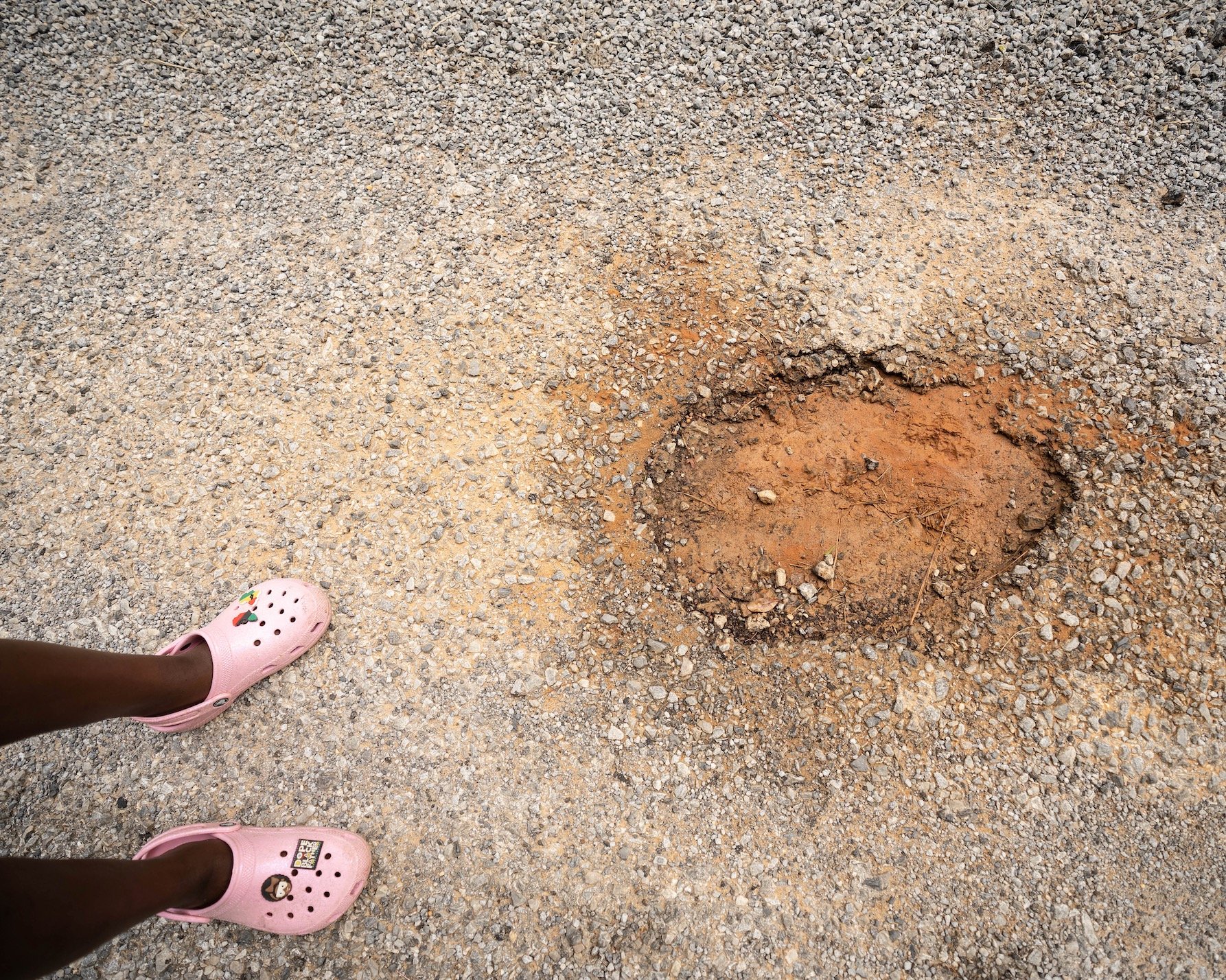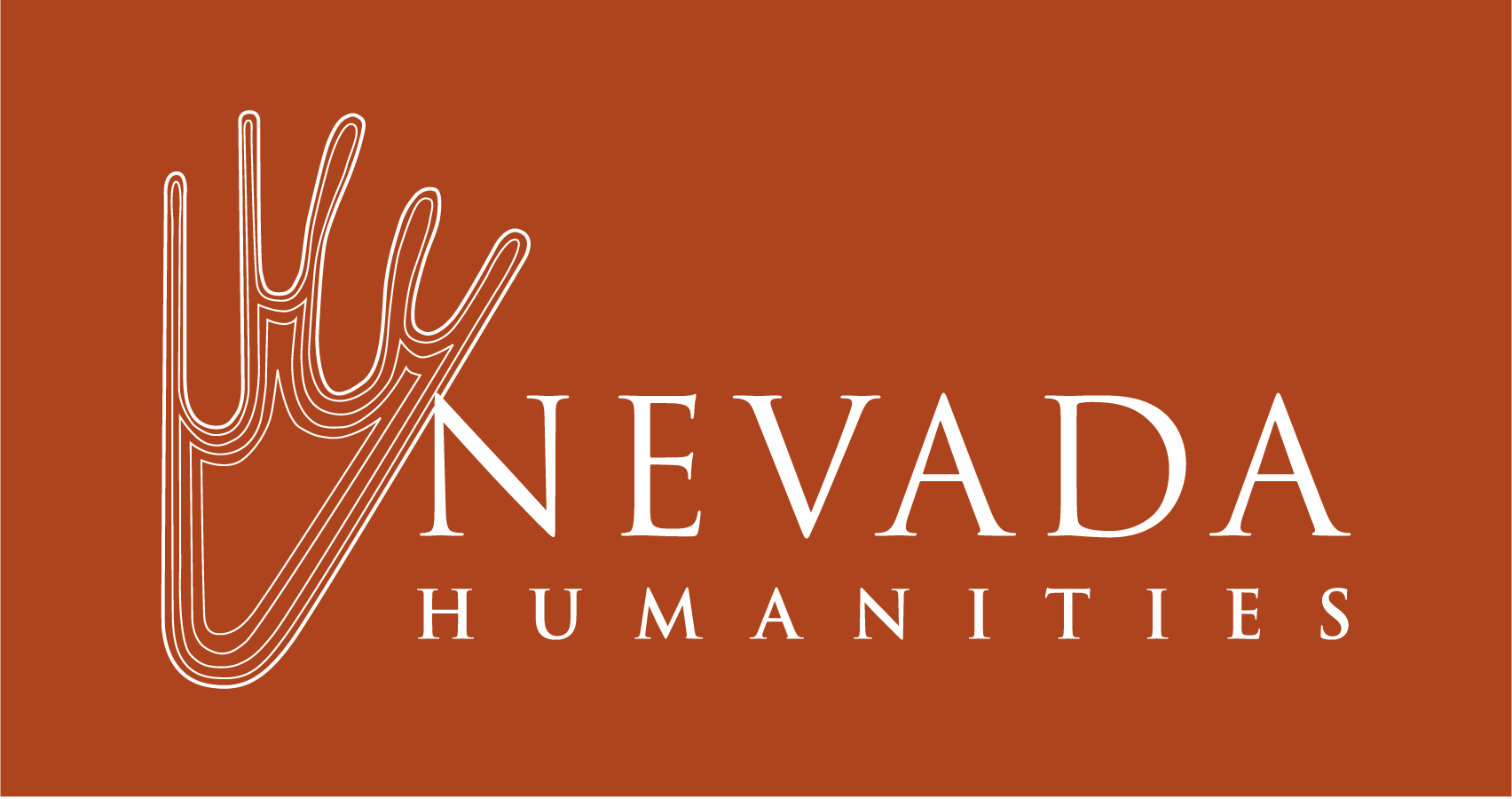Through the Lens: A Conversation with Iyana Esters and Erica Vital-Lazare
Iyana Esters (right) and Erica Vital-Lazare at the opening of Birthed from the soil. Image courtesy of Connie Ann Santos, © Connie Ann Santos.
Birthed from the soil is a photographic project by Iyana Esters featuring Yawah Awolowo (Mama Yawah) — an organic farmer, chef, and midwife from Alabama. The exhibition celebrates ancestral knowledge of working with the earth, community care, and a short history of Black farmers in Nevada. Erica Vital-Lazare — an accomplished author, artist, professor, and influential force in the arts community in Las Vegas — asked Esters a few thought-provoking questions about her work.
Image courtesy of Connie Ann Santos, © Connie Ann Santos.
Erica Vital-Lazare: In your current exhibit Birthed from the soil, you perfect techniques that honor the work and the personal life of Mama Yawah by printing images onto leaves. Why was it important for you to infuse photographic techniques with the natural world?
Iyana Esters: Well… encapsulating Mama Yawah and her world into the things she grows was intentional since it’s a big part of who she is. Printing images mostly on elephant ear leaves using the sun and making sun prints with turmeric — these plants were all things she grew herself and enjoys. It’s a love note using nature immersing her family and community, too!
Black Mother God (a baby photo of Mama Yawah), 2024, Sunprint, 16” × 20”.
Napoleon (grandson of Mama Yawah), 2024, Leaf, 8” × 10”.
EVL: Knowing you and seeing images of the Wedekind Road Art Project — a series of murals created by many artists in Northeast Reno, an area rich in history — I had not been aware of the legacy of Black families, schools, churches and neighborhoods in Reno. Is it the responsibility of the artist, and of your work in particular, to educate in this way?
IE: Absolutely! As an artist you have many unwritten responsibilities if you care as an educator, a historian, a storyteller, a maker and keeper of culture.
EVL: So many of the images by photographer Deanna Lawson celebrate Black bodies that are distinctly New York — Brooklyn in particular. While the work of photographer RaMell Ross has become deeply associated with images of Black life in the South. The texture of your work — your ability to capture light, posture, and presence; telling the story of not only the people within the frame but of a place — is a quality I feel you share with Lawson and Ross. How important is it to you as an artist to make your audience feel the histories of place as context for the subjects at the center of your photographs?
IE: Thank you, friend! I get this deep, familiar feeling when I photograph places and spaces I’ve been — like visiting Tallulah to see my grandma as a little girl or spending summers in Jackson before briefly living there as an adolescent, coming from Nevada. It always felt like stepping into another dimension, exploring something both special and deeply rooted. Working on this project with Mama Yawah — or any of my work, really — feels like sharing pieces of myself and my ancestors. That’s the feeling!
Mama Yawah (second from left) and her family with Iyana Esters. Image courtesy of Connie Ann Santos, © Connie Ann Santos.
EVL: You devote a section of Birthed from the soil to biographies of three Black women in Nevada who purchased, managed, and fought to sustain their own homesteads. How do their lives connect to the lifework, philosophy, and beauty of Mama Yawah?
IE: Mama Yawah embodies a matriarchal spirit, which led me to reflect on the history of Black women in Nevada (including the Obodo Collective). These women — Tempy Robinson, Sophia Miller, and Charlotte Barber — moved west in the late 1800s with families and became leaders after losing their husbands. They, too, were matriarchs, passing down the ancestral knowledge of caring for the land.
EVL: What role do such entities as Nevada Humanities, Nevada Arts Council, and other arts organizations play in supporting you as you develop and plan what you envision next?
IE: I am a firm believer that these stories must be told with love and those who have supported my work are of the essence in my growth as an artist, allowing me to explore my ideas further to bring them into fruition and have a support system with a community of people who truly want the best for me. Thank you all dearly! Xoxo






Image courtesy of Iyana Esters
Iyana Esters combines art with her background in folk herbalism and environmental health, using photography to tell stories that explore humanity’s connection to nature. She experiments with various photographic processes, including documentary, natural plant materials and textiles, and photo mural projects, focusing on stories of gender and ancestry in the Black and Afrodiaspora. In 2024, Iyana completed an artist residency at the Coleman Center for the Arts, an initiative of the Andy Warhol Foundation. She is also the Nevada Arts Council’s 2025 Heritage Fellow, an honor recognizing her contributions to the state’s traditional arts heritage. Instagram: @soulwellknwn
Image courtesy of Erica Vital-Lazare
Erica Vital-Lazare is the founder of Our Mothers’ Gardens Book Festival at Obodo Urban Farm and is a professor of creative writing at the College of Southern Nevada. Vital-Lazare’s grants and awards include the Zora Neale Hurston Foundation, the Hilliard Endowment, and the Nevada Arts Council. Editor of the literary series Of the Diaspora with McSweeney’s Press, Erica is co-producer of the photo-narrative exhibition Obsidian & Neon: Building Black Life in Las Vegas and curator of the 2023 UNLV Majorie S. Barrick Museum exhibit Seeing/Seen, as well as the upcoming Clark County juried exhibit “The Mother's Roots: An Afrodiasporic Experience.”
Birthed from the soil was supported, in part, by the Nevada Arts Council, a state agency, which receives support from the National Endowment for the Arts, a federal agency, and the state of Nevada. Birthed from the soil was also made possible with the generous support of Nevada Humanities, the National Endowment for the Humanities, Black Women Photographers x Nikon, the Lilley Museum of Art at the University of Nevada, Reno, the Coleman Center for the Arts, and Action Camera Reno.







